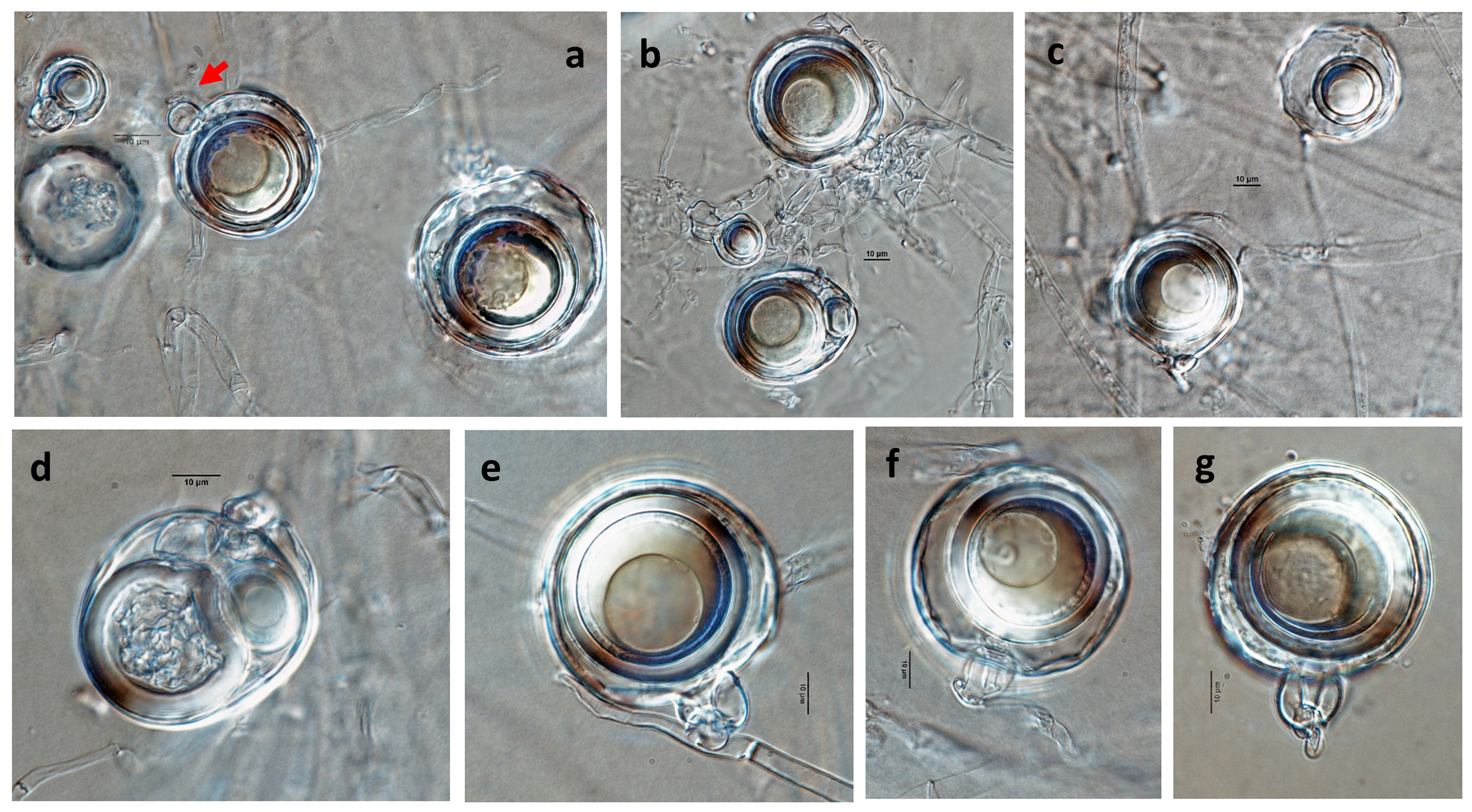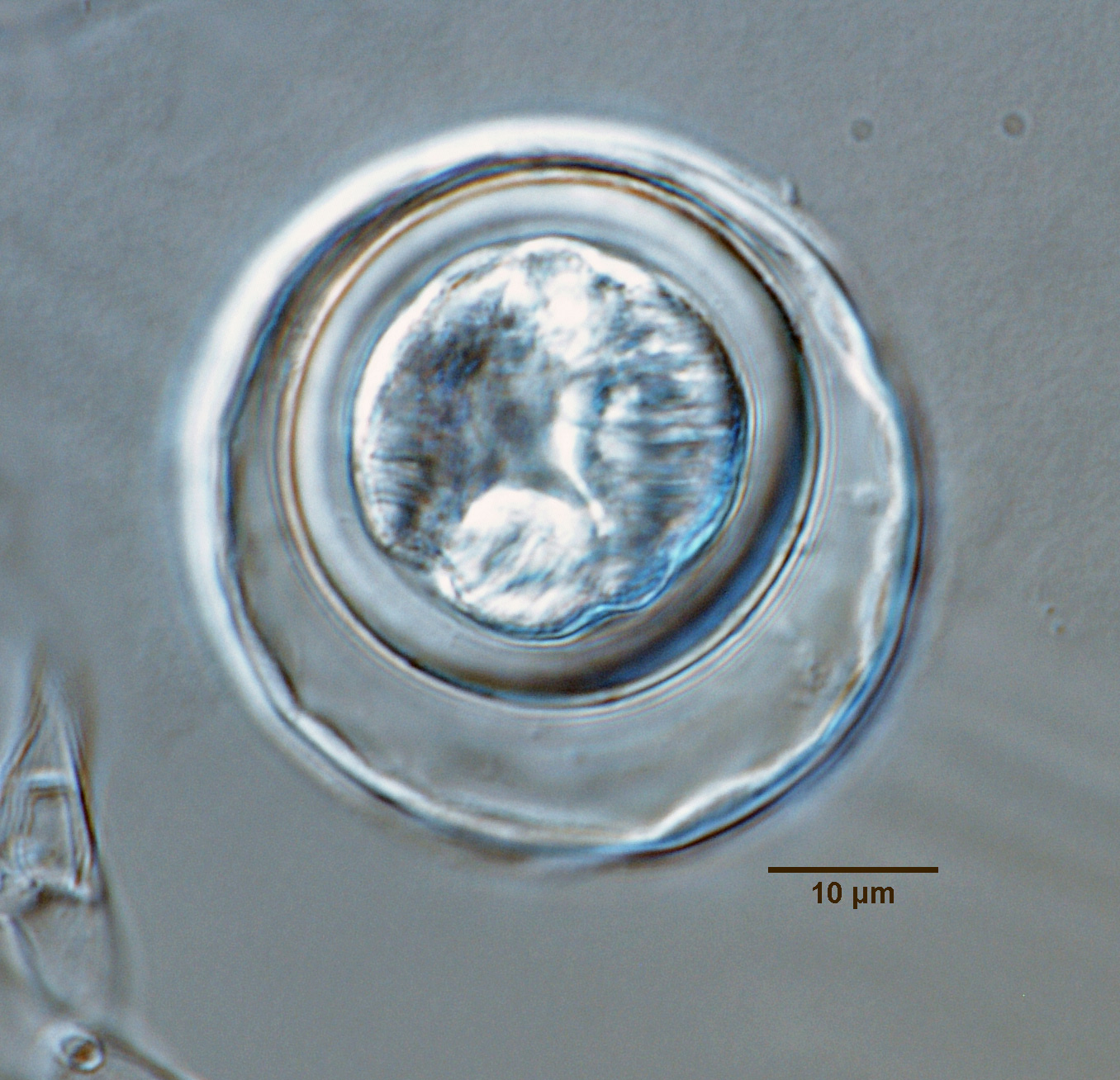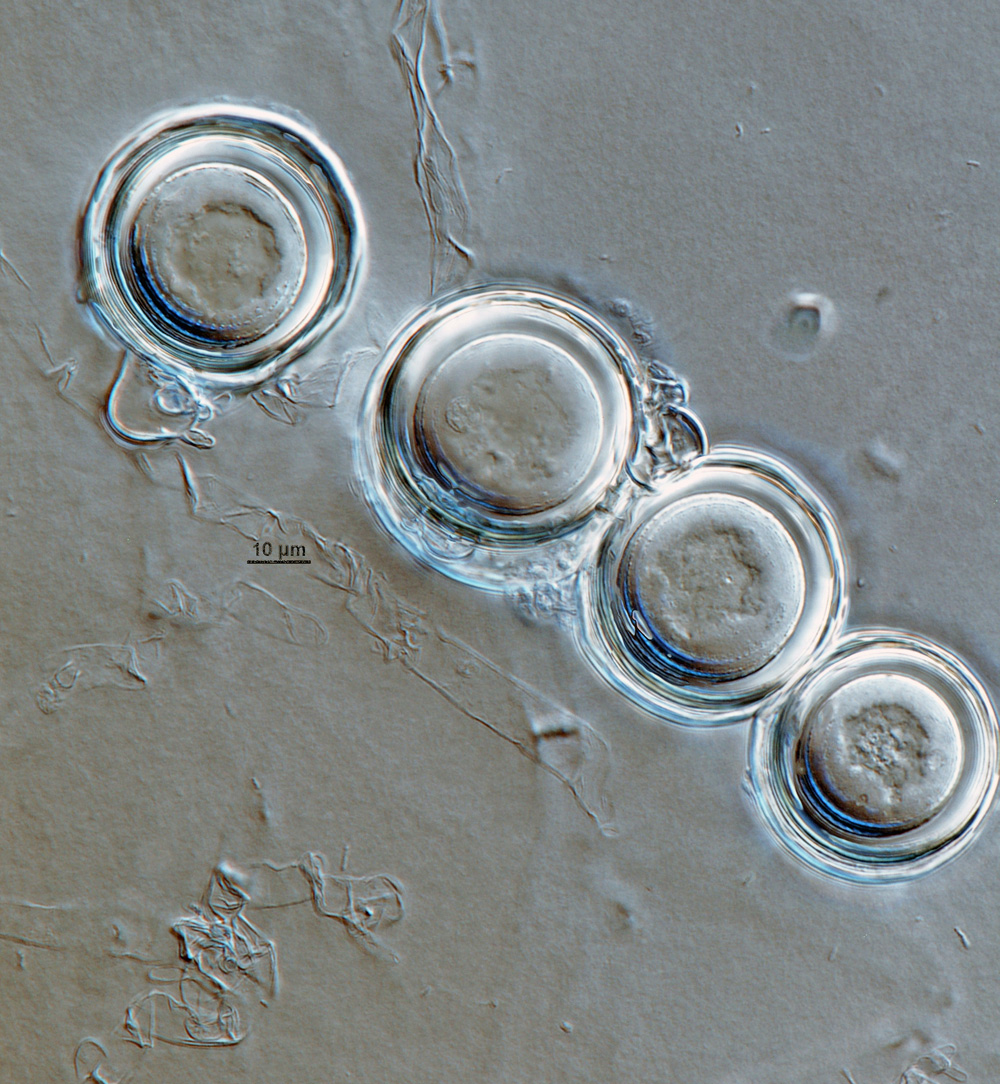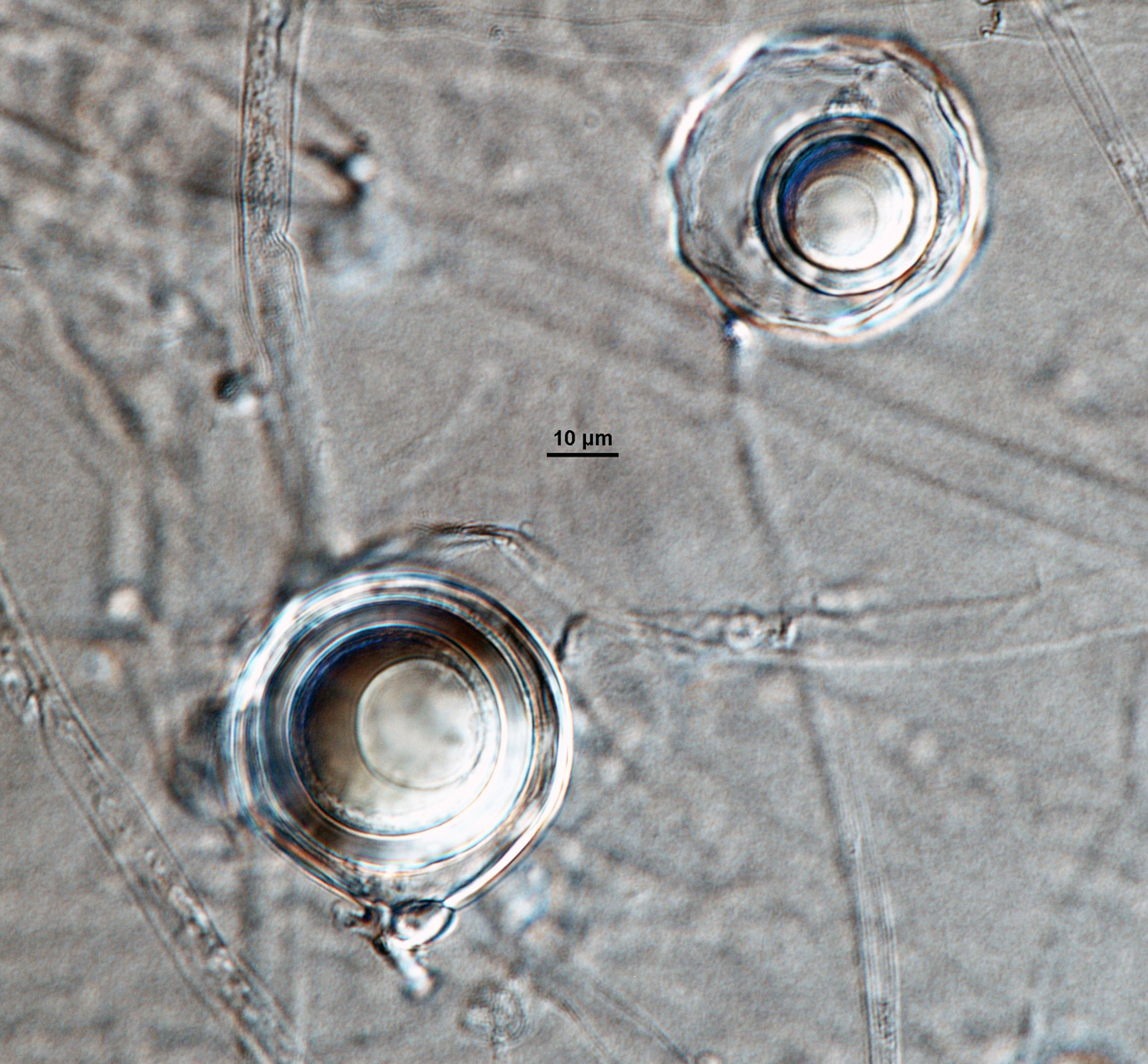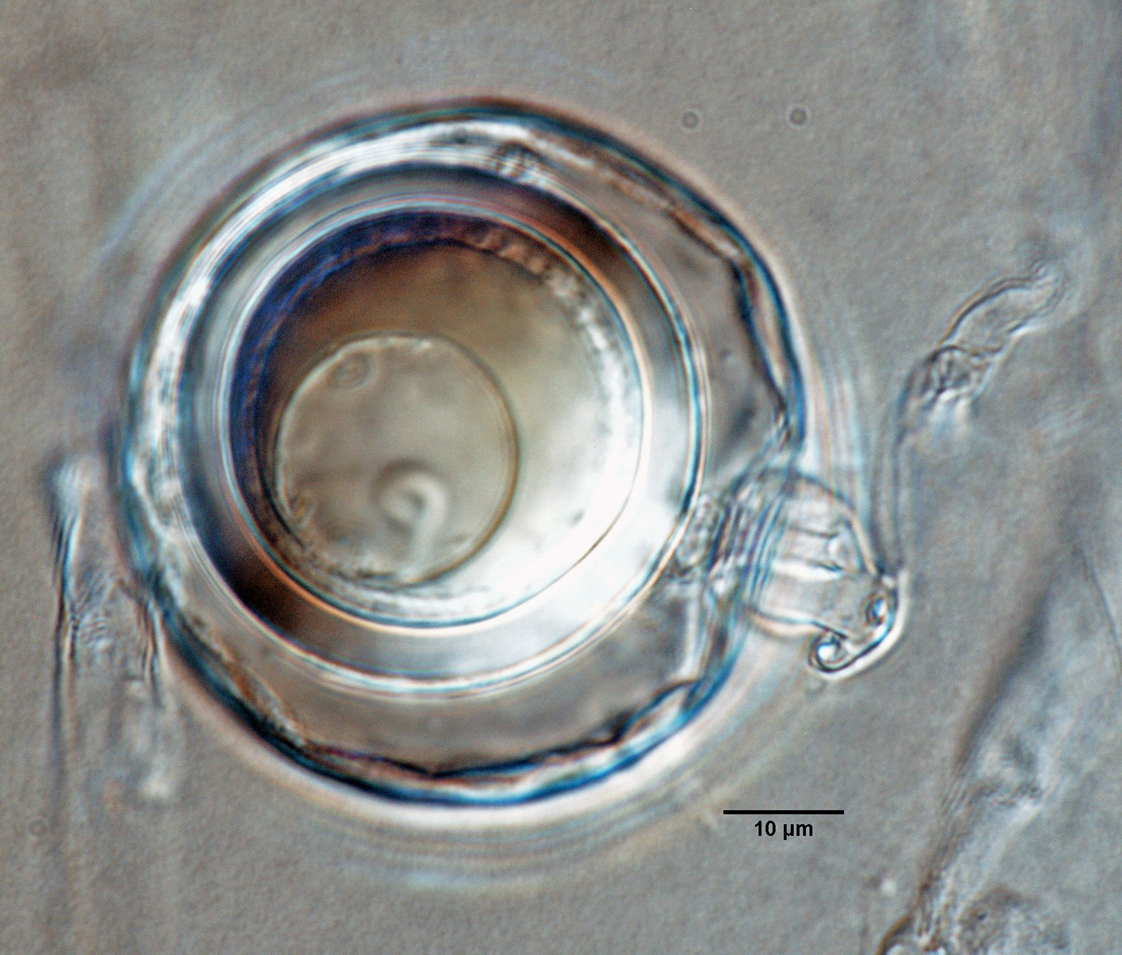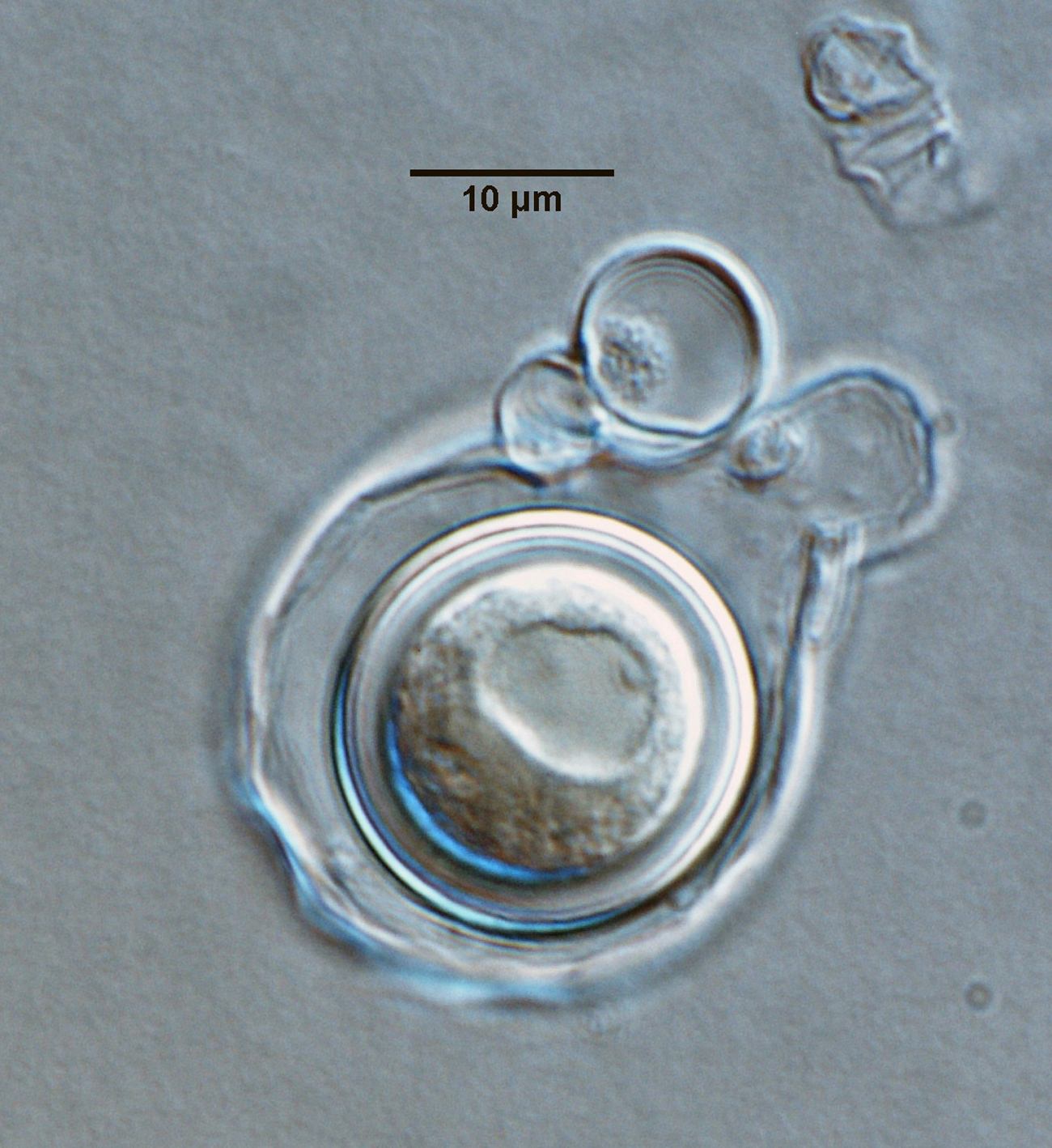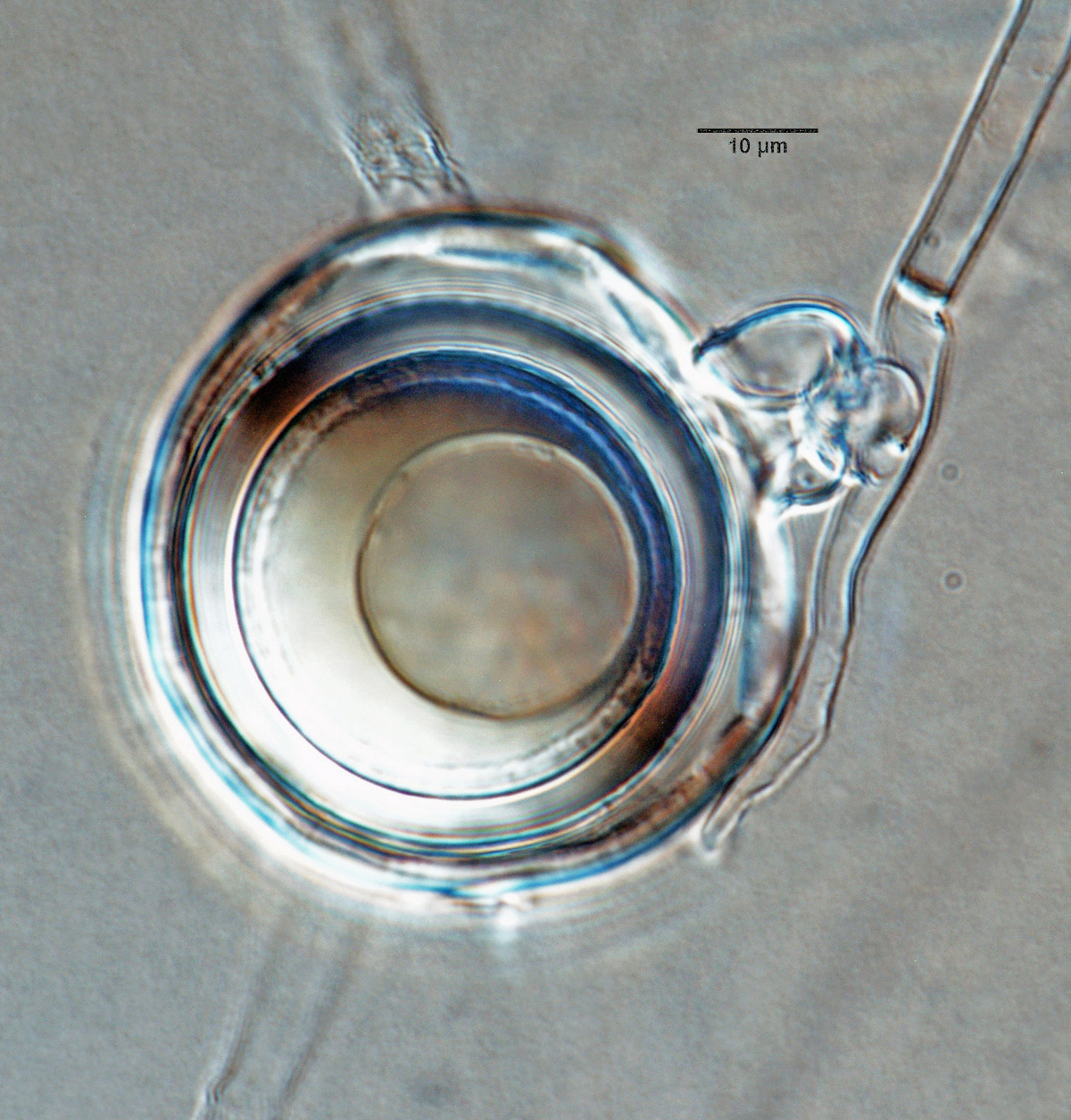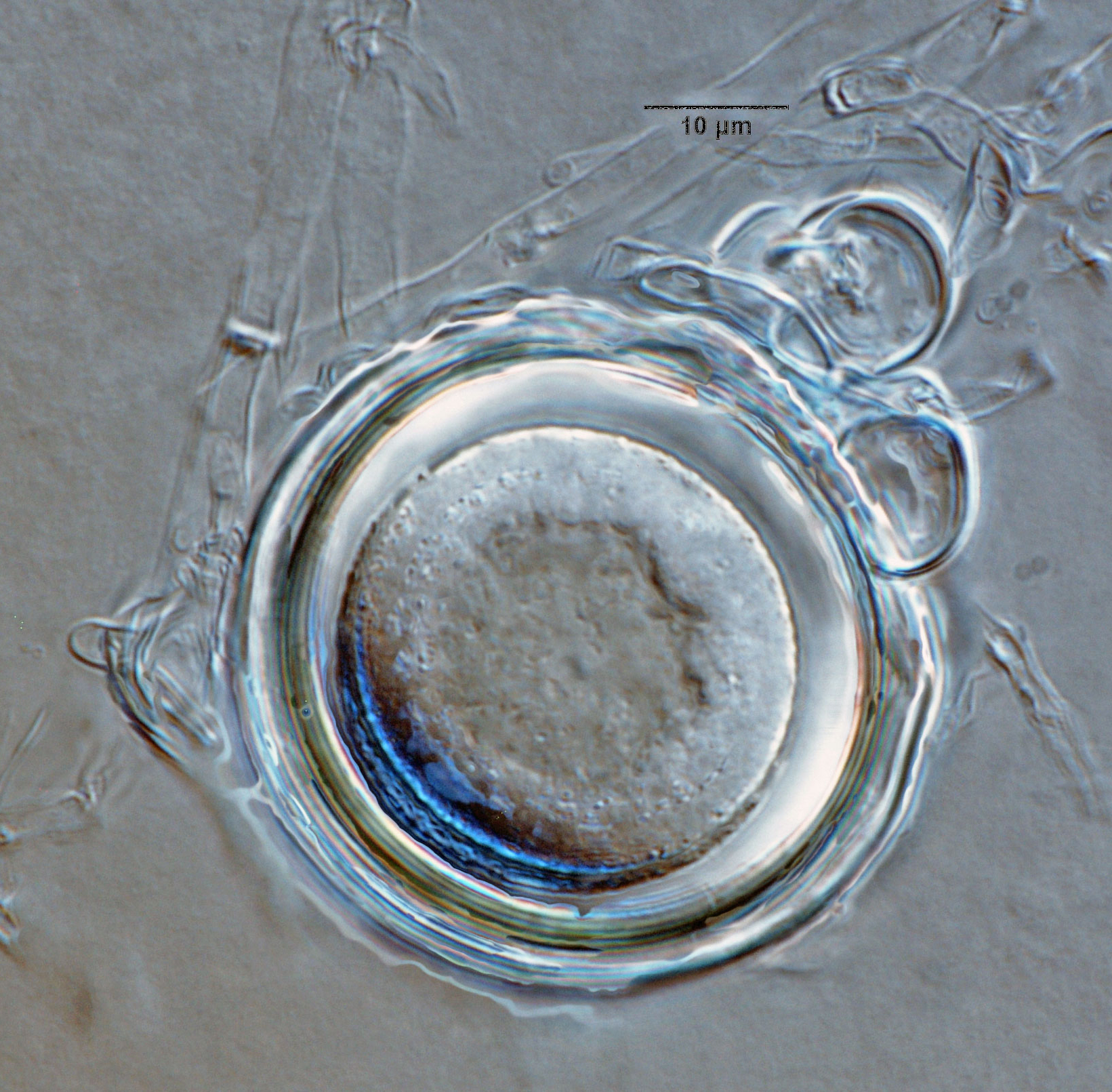Phytophthora sansomeana
|
Phytophthora spp. in subclade 8a: portion of the seven-loci ML phylogeny featuring the type cultures of 212 described species (by T. Bourret). Notice the position of P. sansomeana Ex-type CBS 117693 = S&T BL 55. Gloria Abad, USDA S&T.
|
|
Phytophthora spp. in subclade 8a: Morphological Tabular key (PDF) and Tabular key legends (PDF) in IDphy2 KEY SECTION. Notice the data of P. sansomeana Ex-type CBS 117693 = S&T BL 55. Gloria Abad, USDA S&T.
|
|
Phytophthora sansomeana (CPHST BL 55) colonies of the ex-type grown for 7 days on (a) V8® Agar, (b) potato dextrose agar, and (c) malt extract agar; photo by Krysta Jennings and Leandra Knight, USDA-APHIS-PPQ |
|
Phytophthora sansomeana (ex-type CPHST BL 55) homothallic sexual phase: (a–g) oogonia smooth-walled with predominant amphigynous antheridia (e–g) and paragynous antheridium with finger-like projections (yellow arrow); small oospores (a, b), and two oospores per oogonium (b, d); photos by Gloria Abad, USDA-APHIS-PPQ. |
|
Phytophthora sansomeana (ex-type CPHST BL 55) sexual phase: (a) oogonia with amphigynous antheridia (red arrows) and paragynous antheridium with finger-like projections (yellow arrow); oogonia with plerotic (b), and aplerotic (c, d) oospores; photos by Gloria Abad, USDA-APHIS-PPQ. |
|
Phytophthora sansomeana (ex-type CPHST BL 55) homothallic sexual phase: oogonium smooth-walled with predominant amphigynous antheridium with finger-like projection; photo by Gloria Abad, USDA-APHIS-PPQ. |
|
Phytophthora sansomeana (ex-type CPHST BL 55) sexual phase: oogonium with aplerotic oospore; photo by Gloria Abad, USDA-APHIS-PPQ. |
|
Phytophthora sansomeana (ex-type CPHST BL 55) sexual phase: oogonia with amphigynous antheridia (red arrows) and paragynous antheridium with finger-like projections; photo by Gloria Abad, USDA-APHIS-PPQ. |
|
Phytophthora sansomeana (ex-type CPHST BL 55) homothallic sexual phase: two oospores per oogonium; photo by Gloria Abad, USDA-APHIS-PPQ. |
|
Phytophthora sansomeana (ex-type CPHST BL 55) homothallic sexual phase: oogonia smooth-walled with predominant amphigynous antheridia; photo by Gloria Abad, USDA-APHIS-PPQ. |
|
Phytophthora sansomeana (ex-type CPHST BL 55) homothallic sexual phase: oogonia smooth-walled with predominant amphigynous antheridia; photo by Gloria Abad, USDA-APHIS-PPQ. |
|
Phytophthora sansomeana (ex-type CPHST BL 55) homothallic sexual phase: aplerotic oospore with smooth-walled oogonium and predominant amphigynous antheridium; photo by Gloria Abad, USDA-APHIS-PPQ. |
|
Phytophthora sansomeana (ex-type CPHST BL 55) sexual phase: oogonium with aplerotic oospore; photo by Gloria Abad, USDA-APHIS-PPQ. |
|
Phytophthora sansomeana (ex-type CPHST BL 55) homothallic sexual phase: aplerotic oospore with smooth-walled oogonium and predominant amphigynous antheridium; photo by Gloria Abad, USDA-APHIS-PPQ. |
|
Phytophthora sansomeana (ex-type CPHST BL 55) sexual phase: oogonium with plerotic oospore; photo by Gloria Abad, USDA-APHIS-PPQ. |
Name and publication
Phytophthora sansomeana E.M. Hansen & Reeser (2009)
Hansen EM, Wilcox WF, Reeser PW, and Sutton W. 2009. Phytophthora rosacearum and P. sansomeana, new species segregated from the Phytophthora megasperma "complex". Mycologia 101: 129–135.
Corresponding author: hansene@science.oregonstate.edu
Nomenclature
from Hansen et al. (2009)
Mycobank
Etymology
The name commemorates Dr Eva Sansome, whose astute cytological observations established the diploid nature of Phytophthora and other oomycetes.
Typification
Type: UNITED STATES OF AMERICA, collected from soybean in Indiana by Reeser, isolate OSU 1819B holotype in Herbarium OSC (dried culture)
Ex-type: ATCC MYA-4455
Sequences for ex-type in original manuscript: OSU 1819B = ITS rDNA EU925375
Ex-type in other collections
(ET) CBS 117693, ATCC MYA-4455, WPC P8051, S&T BL 55, 47H3 (Hong)
Molecular identification
Voucher sequences for barcoding genes (ITS rDNA and COI) of the ex-type (see Molecular protocols page)
Phytophthora sansomeana isolate CPHST BL 55 (= P8051 WPC) = ITS rDNA MG865585, COI MH136977
Voucher sequences for Molecular Toolbox with seven genes (ITS, β-tub, COI, EF1α, HSP90, L10, and YPT1
(see Molecular protocols page) (In Progress)
Voucher sequences for Metabarcoding High-throughput Sequencing (HTS) Technologies [Molecular Operational Taxonomic Unit (MOTU)]
(see Molecular protocols page) (In Progress)
Sequences with multiple genes for ex-type in other sources
- NCBI: Phytophthora sansomeana CPHST BL 55
- EPPO-Q-bank: Phytophthora sansomeana CBS 117693 ITSrDNA, β-tub, TEF
- BOLDSYSTEMS: Phytophthora sansomeana (barcoding COI & ITS)
Position in multigenic phylogeny with 7 genes (ITS, β-tub, COI, EF1α, HSP90, L10, and YPT1)
Clade clade:
a taxonomic group of organisms classified together on the basis of homologous features traced to a common ancestor
8a
Morphological identification
adapted from Hansen et al. (2009)
Colonies and cardinal temperatures
Colony colony:
assemblage of hyphae which usually develops form a single source and grows in a coordinated way
after 7 days of growth on potato dextrose agar, malt extract agar with slight chrysanthemum pattern, and in V8 agar with no distinct pattern. Minimum growth temperature 3°C, optimum 24–30°C, and maximum 33°C.
Conditions for growth and sporulation
Sporangia form in water; hyphal swellings are sometimes observed in old water cultures.
Asexual phase
SporangiaSporangia:
sac within which zoospores form, especially when water is cooled to about 10°C below ambient temperature; in solid substrates, sporangia usually germinate by germ tubes
nonpapillatenonpapillate:
pertaining to the production of a non-distinct, or inconspicuous, papilla at the distal end of the sporangium (cf. papillate and semipapillate)
, persistentpersistent:
pertaining to sporangia that remain attached to the sporangiophore and do not separate or detach easily (cf. caducous)
; ovoidovoid:
egg-shaped, with the widest part at the base of the sporangium and the narrow part at the apex
, obpyriformobpyriform:
inversely pear-shaped, i.e. with the widest part at the point of attachment (cf. pyriform)
, ellipsoidellipsoid:
refers to a solid body that forms an ellipse in the longitudinal plane and a circle in cross section; many fungal spores are ellipsoidal or elliptic
, obovoidobovoid:
inversely egg-shaped; ovoid, but with the widest part at the apex
(30–53 L x 19–40 W µm) some with distorted shapes and some with tapered bases; presenting internal proliferationinternal proliferation:
internal proliferation occurs when the sporangiophore continues to grow through an empty sporangium
, produced on long, unbranched or loosely sympodial sporangiophores. Hyphal swellings globoseglobose:
having a rounded form resembling that of a sphere
, subglobose, with radiating hyphaehyphae:
single, tubular filament of a fungal or oomycete thallus; the basic structural unit of a fungus or oomycete
produced on clusters or catenulated. ChlamydosporesChlamydospores:
an asexual spore with a thickened inner wall that is delimited from the mycelium by a septum; may be terminal or intercalary, and survives for long periods in soil
absent.
Sexual phase
Homothallic. Oogonia smooth-walled, globoseglobose:
having a rounded form resembling that of a sphere
(25–52 µm diam); antheridiaantheridia:
the male gametangium; a multinucleate, swollen hyphal tip affixed firmly to the wall of the female gametangium (the oogonium)
small (6–24 L x 9–16 W µm) predominately amphigynousamphigynous:
pertaining to the sexual stage in which the antheridium completely surrounds the stalk of the oogonium (cf. paragynous)
and sometimes with digitate projections; oosporesoospores:
zygote or thick-walled spore that forms within the oogonium after fertilization by the antheridium; may be long-lived
globoseglobose:
having a rounded form resembling that of a sphere
(23–44µm diam) pleroticplerotic:
pertaining to an oospore that fills the oogonium (cf. aplerotic)
, apleroticaplerotic:
pertaining to a mature oospore that does not fill the oogonium; i.e. there is room left between the oospore wall and oogonium wall (cf. plerotic)
, or slightly apleroticaplerotic:
pertaining to a mature oospore that does not fill the oogonium; i.e. there is room left between the oospore wall and oogonium wall (cf. plerotic)
.
Additional specimen(s) evaluated
Phytophthora sansomeana ex-type CPHST BL 55, duplicate of P8051 (World Phytophthora Collection), which is a duplicate of ex-type ATCC MYA-4455
Hosts and distribution
Distribution: North America (USA), Asia (China)
Substrate: roots, collar
Disease note: root rot
Host: Glycine max (Fabaceae), various other hosts
Retrieved February 01, 2018 from U.S. National Fungus Collections Nomenclature Database.
Additional info:
Substrate: rhizosphere
Additional references and links
- SMML USDA-ARS: Phytophthora sansomeana
- EPPO Global Database: Phytophthora sansomeana
- Forest Phytophthoras of the world: Phytophthora sansomeana
- CABI Digital Library: Phytophthora sansomeana
- Encyclopedia of Life (EOL): Phytophthora sansomeana
- Index Fungorum (IF): Phytophthora sansomeana
- Google All Phytophthora sansomeana
- Google Images Phytophthora sansomeana
- Google Scholar Phytophthora sansomeana
Fact sheet author
Z. Gloria Abad, Ph.D., USDA-APHIS-PPQ-S&T Plant Pathogen Confirmatory Diagnostics Laboratory (PPCDL), United States of America.


